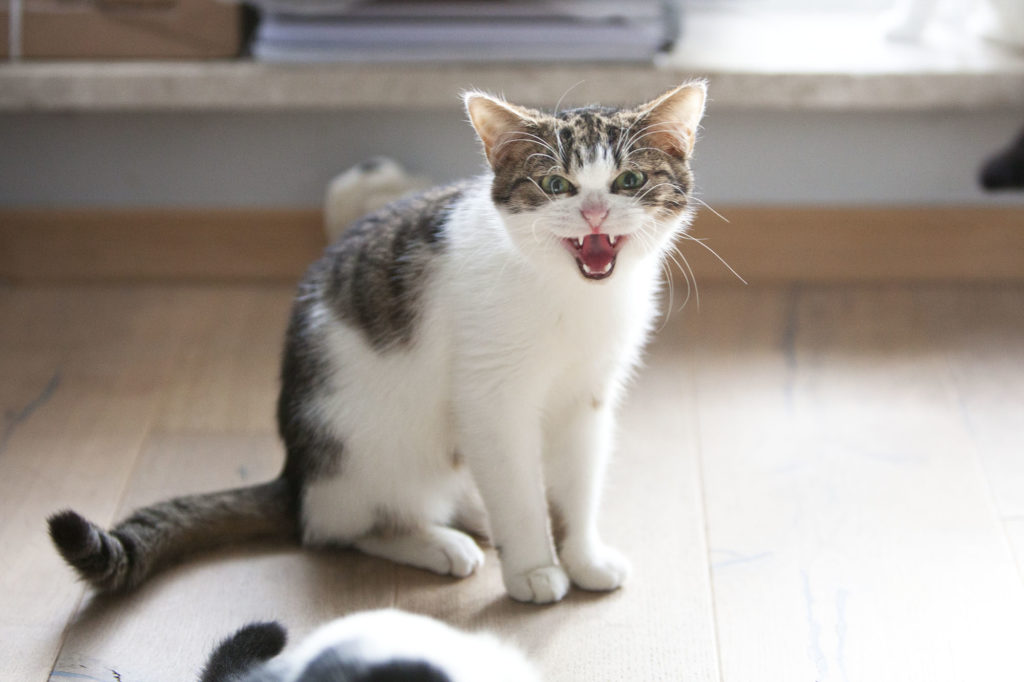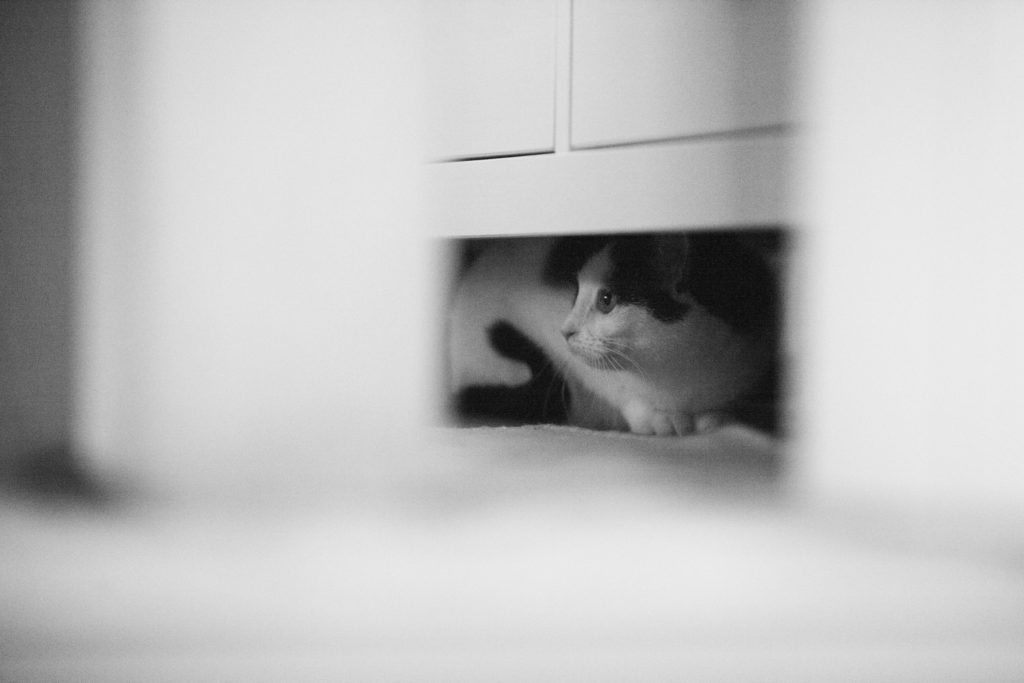Cat’s behavior
I always say that the greatest curse of cats is their marvelous appearance. They are small, fluffy balls that remind us of cuddly toys, at the same time evoking motherly feelings. Most people when taking small cats under their roofs have a picture of cleaning the litter box once a day, giving dry food to eat, and sitting in the evenings with hot tea and a book while the cat is keeping their feet warm. Unfortunately, our ideas about cats often (not always, but often) collide with reality after only a few weeks of living together. The cat begins to wake us up at 3 am, the cat urinates outside the litter box, the cat scratches furniture and jumps onto the table during our meals. Such hehavior is tolerated as long as the cat is young because we feel sorry for him and we say to ourselves that he is young and this behavior will pass, we clean after him and we throw him some food from the table so that he does not feel bad looking as we eat.
Time passes, the cat is growing up and we don’t laugh any more. We say that the cat is mean, we cannot deal with him, and we certainly are not enjoying the cohabitation any more. What happens next? Either we continue living together but at the same time separately – the cat has depression, fears, and his life quality on a scale from one to ten I would score as two, three max. Another option is to give the cat to someone who theoretically will take care of him, but in fact he will have the same problems with him, and the third option is taking the cat to the shelter or throwing him out to live in the street. Those who read this and have nothing to do with helping homeless animals probably think “what a nonsense and exaggeration.” Those who deal with animals in shelters and foundations think “this is our everyday life”.

I am very happy when I get your emails and messages asking for help because despite the problems you encounter while living with a cat you are looking for ways to solve them. This is a very big part of the success so I congratulate all of you! What saddens me the most is the fact that there are so many people who live with a cat and have problems with him so severe that both of them can rate their life quality at maximum 3 and yet very very few of them will think about fixing these problems. The animal behaviorist is still not very popular in Poland. Fortunately, its popularity is slowly growing, and thus the life of our cats and dogs is getting better and happier and less abounding in the poor mental state of our animals.
Cat behavior. What is a behavioral problem?
First of all, we need to explain what the behavioral problem is. It is a cat’s behavior that is not accepted by a man and at the same time it makes the cat’s quality of life low. Here are some examples of reasons: inadequate socialization (or lack of it), health problems and unmet cat’s ethogram (a set of all natural behaviors of this species in the natural environment). Comparing dogs and cats, more often people come to a behaviorist with dogs than cats. Why? The main reason is not the fact that cat problems are less frequent but how cat’s problems affect people. If a dog is fearful, aggressive and barks for eight hours during the owner’s absence at home, this problem impacts the owner much more than when his fearful cat sits in the closet for days pretending that he is not there. Until the cat attacks us, urinates all over the apartment or scratch all the furniture, we do not even think about going to someone for help, and even if he does, often the only solution we see is to give the pet away. This is sad, but in my opinion very true.
If you have one of these problems with your cat:
-
Cat urinates and defecates outside of the litter box
-
Cat is aggressive
-
Cat vomits very often but doesn’t have any health disorders
-
Cat scratches himself to the point of causing wounds
-
Cat never wants to play and only comes out of the hiding place when people are not around
-
Cat is afraid of sudden movements, children, strangers and is permanently exposed to these stimuli
-
Cats fight at home all the time
Do yourself and your cat a favor and go to a cat behaviorist. Let him explain why such a problem can take place in your home and let him tell you how to deal with this situation.
Where do unwanted cat behaviors come from?
Cats are really wild animals. Recently during the class in COAPE school, the lecturer showed us movies of small kittens and asked about a hundred of us, people who on a daily basis work or to a large extent deal with animals, whether the cat that we see in the film is our wonderful European cat or wild cat living in the deepest parts of Africa. Most of us did not know. It shows how small is the difference between wild African cats and our kitty cats. The difference in their life needs and appearance is insignificant, but our attitude towards the representatives of these two groups is diametrically different. See for yourself:
Cat’s behavior – cat’s ethogram – what is it?
Remember that each dog as well as every cat has something called an ethogram, that is a set of all typical behaviors of a given species in its natural environment. If we take a cat under our roof and want him to stop doing things typical for him, it’s a bit like giving birth to a child and demand that he never cry. At the very beginning, crying is probably the only way a child can tell his parents that he is hungry, cannot sleep or something hurts him and we cannot stop it because it is a natural thing, a part of a newborn child, but how to deal with it and calm the child is a completely different matter. It’s the same with a cat. If we think that the cat will not scratch, we’re wrong. The cat must scratch because it is part of his behavior related to play and chemical communication, but whether he will scratch our furniture or places specially designed for this purpose is a different matter.
I hope most of you know that cats are not mean. Any cat behavior not accepted by us, among those I mentioned earlier, may have several reasons. They are results of situations problematic for our cat and through his behavior cat tries to communicate something. We cannot read these messages thinking the cat is spiteful or that he has a medical problem, or the behaviors are a result of bad socialization, or a lot of other aspects many people have already written books about. Remember that the cat has five ways to deal with stress, two of which are most common (so-called 5F):
-
- FLIGHT
-
- FIGHT
-
- FREEZE
-
- FAINT
-
- FOOL AROUND OR FIDGET
If a cat attacks your arms and legs, if it bites when you stroke him, if it hides under a bed or in the closet, and you think that he is just that type, that he is a “loner,” then you should know that there is a high probability that your cat is experiencing a lot of stress and his behavior is the result of this stress. You can search for the causes yourself, but if you fail, then report to a feline behaviorist who will help you find them.

When to report to a feline behaviorist? Cat behavior that needs to be corrected.
If your cat is aggressive, the cat is stressed or still displays other behaviors that you consider abnormal and you cannot deal with them yourself, ask a specialist for help.
How does a behavioral advice look like?
First of all animal behaviorist should, in cooperation with the vet, exclude the medical background of the problem. Urinating outside the litter box does not necessarily have to be the result of a covered litter box or bad litter, but also for example bladder infection or kidney disease. If we do not exclude the medical problems first, even with the best behavioral skills, we will not help the cat. If we exclude the health issues, we can conduct an interview and learn the history of the cat and the background of the problem. We need to look around and examine the space in which the animal lives, get to know people who take care of the cat and their attitude towards the pet, learn about the cat’s diet, lifestyle and habits. We need to determine what is the exact problem with the cat, what is the cause of the problem, determine the steps that will change the unwanted behavior, and form a behavioral opinion. It is also important to check how the owners work with the cat and correct any mistakes. At the very end, there is a point called “Change of behavior”, which with the proper guidance of the pet and its owner and assuming that change is possible, will take effect and our relationship with the animal and its welfare will change.
Why is consulting an animal behaviorist a great idea?
First of all, you must realize that the cat has a problem and you have a problem too. Then you have to realize that such a state is not normal, and the situation can most likely be improved. Then find an animal behaviorist and try to help yourself and your pet.
The truth is that you often spend more money, time and nerves on fighting the effects than if you trusted an animal behaviorist and, instead of fighting the effects, you would prevent them. If we all had more knowledge about cats, how they behave and how we should deal with them, then there would be fewer homeless animals, more cats staying at our homes would be happy and would not experience constant stress, and we would not hand the cat around (if lucky enough) like something that you can give to someone as a “gift” in case of a problem. If only we knew …




